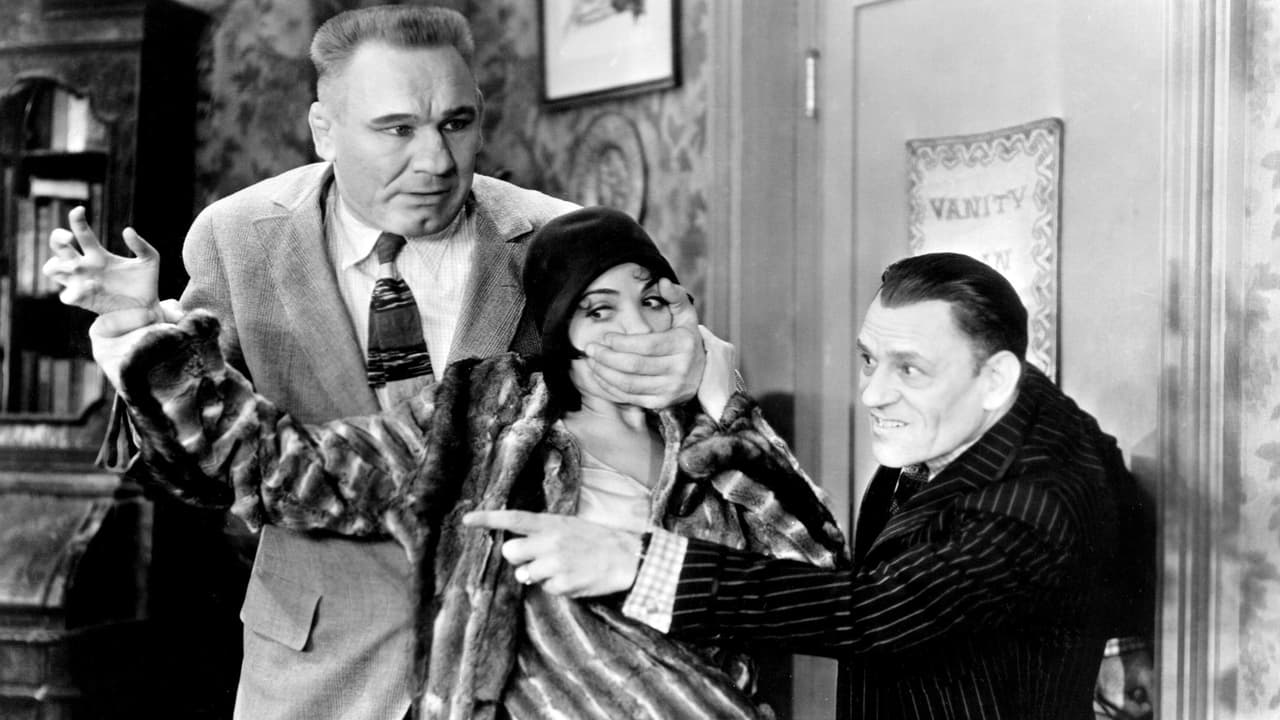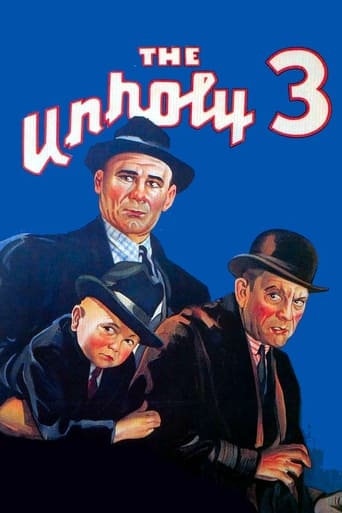Smartorhypo
Highly Overrated But Still Good
InformationRap
This is one of the few movies I've ever seen where the whole audience broke into spontaneous, loud applause a third of the way in.
Sabah Hensley
This is a dark and sometimes deeply uncomfortable drama
Sarita Rafferty
There are moments that feel comical, some horrific, and some downright inspiring but the tonal shifts hardly matter as the end results come to a film that's perfect for this time.
bsmith5552
If anyone doubted that Lon Chaney could make the transition from silent to talkies, they needn't have worried. In his only talkie, Chaney displayed a speaking voice that perfectly matched his physical appearance."The Unholy Three" is a re-make of Chaney's 1925 film of the same name. It follows the same story line of three frustrated side show performers and one pick-pocket carrying out a series of robberies under the cover of a "Bird Store". Echo (Chaney), Tweedledee a baby faced midget (Harry Earles who repeats his role) and Hercules (Ivan Linov) form an alliance -- "The Unholy Three". Rosie (Lila Lee) is a thinly disguised street walker who picks pockets and has an "arrangement" with Echo.Echo, disguised as Grandma O'Grady uses his skills as a ventriloquist to dupe rich clients into buying a "talking parrot". When the customer complains, Grandma and her "Grandson" go to the client's home. While Grandma again convinces the client that they have a talking parrot, "baby" cases the joint for a robbery.Meanwhile Rosie strikes up a relationship with Harry the store's clerk much to the chagrin of Echo. On Christmas Eve, the three are planning another robbery but Echo becomes jealous of Rosie's romance and remains behind. The giant and the midget carry on and the client winds up dead. The trio then plans to pin the crime on hapless Harry to the dismay of Rosie.Harry is arrested and Rosie is swept off with the "three" to a remote cabin. Meanwhile Harry goes to trial. Rosie pleads with Echo to intervene promising to remain with him if he does. Then Things get interesting and....................................Chaney, who could have also been called "the man of a thousand voices" had he lived, uses his voice as the grandma, Echo, Echo's dummy and the parrot to great effect. He is very convincing as the old lady and it's interesting to see his transformation to the gruff Echo as soon as he takes off the wig. Harry Earles was easier to understand with sub-titles. Lila Lee is quite good as Rosie as she at first tries to discourage Harry from loving her. The best that can be said about Ivan Linov is that he was no Victor McLaglan (in the 1925 version).The ending is somewhat different from the silent version. In this version Grandma takes the stand in court whereas in the silent Echo does so. There is an interesting "unmasking" scene in the court room that might remind Chaney fans of a similar scene in "The Phantom of the Opera" (1925).Chaney might have gone on to bigger and better things in talkies but for his untimely death. He was rumored as being considered by Universal for their upcoming "Frankenstein" and "Dracula" films.There is a poignant moment in the final scene where Chaney is standing on a train pulling away, seemingly is waving good bye to his fans. There will never be another Lon Chaney.
poe426
"The Man of a Thousand Faces" might just as well have been labeled "The Man of a Thousand Voices." In his single talkie, he plays a ventriloquist who can throw his voice or completely disguise it (as he does when he dons his "Grandma O'Grady" getup, or when he provides the voice for a "talking" parrot). THE UNHOLY THREE also happens to be a VERY funny movie- thanks in large part to Lon Chaney: his reactions (especially his expressions) to the back-stabbing done by his grifter cohorts are priceless and, more than once, he even manages to outwit himself. His makeup is flawless, as are his mannerisms, his posture, and even his walk. He leaves no stone unturned. Chaney showed signs of great promise here and may very well have been on the verge of redefining himself as well as rewriting the book on acting. Unfortunately, this was "The Man of a Thousand Faces" taking his final bow.
wmorrow59
The 1930 version of The Unholy Three boasts a distinction that guarantees it permanent special status among film buffs: the great silent star Lon Chaney made his only talkie appearance here, shortly before his death from throat cancer at the age of 47. And it's worth noting that this a faithful remake of the 1925 silent version in which Chaney also starred, thus giving us a rare chance to compare two performances by the same actor in the same role but in two very different formats, and to compare the handling of the same material before and after the coming of sound. (When Hollywood remade hits from the silent era the lead roles were almost always recast; parts once played by Doug Fairbanks would go to Errol Flynn, Valentino's would go to Tyrone Power, etc.) This summer I was lucky enough to see restored prints of both versions of The Unholy Three back-to-back at the Museum of Modern Art in NYC, and the experience was fascinating.The plot has been outlined in detail elsewhere, but briefly it involves the criminal career of a trio from the "carny" world: a ventriloquist called Professor Echo (Chaney) who masquerades as an old lady, a strongman, and a midget who disguises himself as a baby. A pet shop is the front for their activities. The trio is accompanied by a thief named Rosie, and a patsy named Hector they've employed who is unaware of their identities and plans. When a heist goes awry the members of the gang turn against each other, and violence erupts.Based on my recent viewings I feel the silent version holds up best. This off-the-wall material plays better in the silent medium, though I found it surprising how similar the two films are when viewed consecutively. When Jack Conway took on directing chores for the remake he must have had a print of the 1925 version available for close study, because there are several sequences in which he follows Tod Browning's editing rhythms and scenic compositions almost exactly. (One example of the latter: the shadow images of the title characters' silhouettes, thrown onto a wall while they plot together.) Even the dialog in the talkie frequently quotes the silent version's title cards verbatim. The biggest change comes in the courtroom finale, where sound allowed the filmmakers to utilize Prof. Echo's vocal talents more creatively. The outcome of the trial is also different in the remake, and somewhat more believable; although the audience at MoMA was respectful toward both films the verdict in the silent version was greeted with a burst of laughter.Why is the silent version the stronger of the two? Certainly Chaney gives a charismatic performance in both films, somehow carrying the viewer past numerous credibility stretchers through sheer force of personality. In the talkie version he demonstrates a fine voice, deep and a little raspy (possibly a result of his medical condition), not unlike Wallace Beery's. Chaney is terrific in both films and is the main reason to see the remake. The 1930 version follows the original so closely we can't blame the writers for going astray, nor are the film's shortcomings entirely the fault of director Conway, at least where visual style is concerned, for he followed Browning's original almost shot-for-shot. No, I believe the difference has to do with the aesthetic gulf between silent and sound film. We're willing to suspend disbelief when watching a silent movie: we'll accept crazy events in silent cinema that would be unacceptable, absurd, or even horrifying (in the wrong sense of the word) in the world of sound. Case in point: one of the most outlandish elements can be found at the pet store, where the proprietors offer birds, hamsters, rabbits -- and a dangerous gorilla, confined in a big cage. No one seems to consider the gorilla's presence unusual. In the silent version, we note this oddity and roll right along. But in the talkie, the gorilla is laugh-provoking; and it doesn't help that instead of the actual simian used in the silent film, the 1930 version features a man in a highly unconvincing ape suit, the sort of tatty-looking costume you'd expect to find in a Bowery Boys comedy.Talkies aren't just silent movies with sound added, they're a new world with different rules, especially where pace is concerned. Early talkies tend to drag, and this one is no exception. Although the remake follows the original closely it feels slower because director Conway and his colleagues hadn't mastered the new medium; they hadn't yet developed that rat-a-tat editing tempo we find in the gangster movies and musicals produced just a year or two later. And although Chaney handled his dialog deftly some of his co-stars did not: both strongman Ivan Linow and "baby" Harry Earles speak with thick accents that are difficult to understand.It's fascinating to see (and hear) Chaney in a talkie, but the remake is fairly slow going. The second Unholy Three is a film that requires patience for the average viewer, though it's a must for anyone with an interest in early talkies, the silent era, and, of course, its star performer. I only wish Lon Chaney had recovered and lived to make more films, once Hollywood's directors had grasped the demands of the new technology and learned to make slicker, more stylish movies that would have displayed his talents to better advantage.
Neil Doyle
LON CHANEY delivers an interesting performance (especially when posing as a kindly old woman), but not even the great Chaney can overcome all the defects in this remake of the 1925 silent.For starters, the performances around him include two extremely bad examples of early screen acting--from awkward Lila Lee and a young man who would later turn his talent to directing rather than acting--Elliot Nugent. Nugent has the hapless role of an innocent, naive young man and plays it in hopelessly nerd style--a foretaste, perhaps, of his Broadway role as the timid professor in THE MALE ANIMAL. Anyway, his is the weakest performance in the film with Lila not far behind.The tale itself is interesting enough to hold the attention--and especially chilling is the malice (pure evil) displayed by Harry Earle as the malevolent midget. Unfortunately, most of his dialogue is unintelligible due to his German accent, something director Jack Conway should have noted.Only real satisfaction is watching Lon Chaney in one of his last roles. He is excellent and makes it painful to realize he was fighting throat cancer while filming was underway. A better script, production values, and tighter direction by Conway would have worked wonders to make this tale more chilling and believable. Summing up: At best, it is an interesting example of Chaney's considerable talent despite the primitive acting technique displayed by Lila Lee and Elliot Nugent. Nugent's performance makes one grateful he switched to directing later in his career, with more satisfying results.

